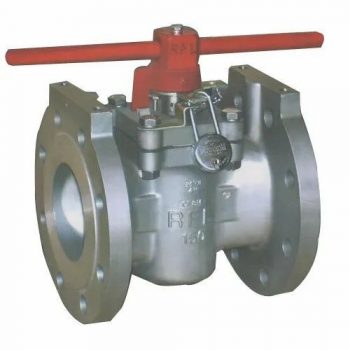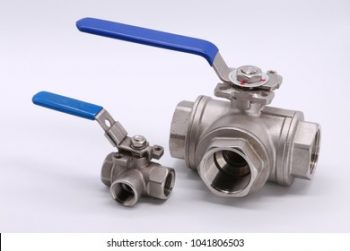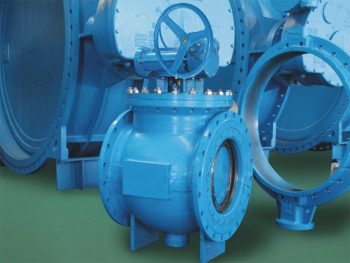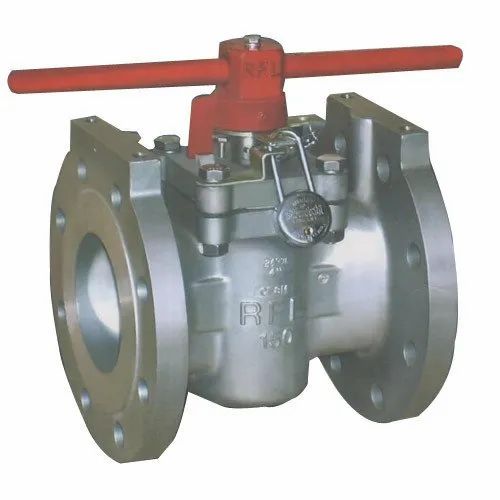Control valves, which monitor, control, and manipulate the flow of the medium through various piping systems, come in two types – plug valve and ball valve. The point of contention now is; Are plug valves better than ball valves? The answer is ‘No.’
Although both valves are similar in their operations and functions, we’ll further compare them in terms of construction, working principle, cost, application, etc., as we consider the slight differences.
Plug Valve vs. Ball Valve: What Are They
Plug Valve

Image Source: IndiaMART
A plug valve is a control valve with a conical tapered or cylindrical disc that controls fluid movement via one or more passages that run sideways through the plug. It has a 90-degree rotation that closes the valve and blocks fluid flow, making it different from an eccentric plug valve. This quarter-turn valve uses an offset (eccentric) valve to regulate wastewater flow.
Plug valves are small, simple, and majorly used for cutting, distributing, or channeling media flow. Its primary applications are in medium or low-pressure, low-temperature settings, although some specific types of plug valve work in high-temperature settings also.
Ball Valve

Image Source: Shutterstock
Ball valves are a modified version of plug valves featuring a spherical disc and a circular bored passageway. The spherical disc has a hole called a port which aligns with both ends of the valve allowing for the opening and closing of the valve.
The primary function of the ball valve is to cut off, distribute, and alter the flow of direction of the medium. And has characteristic features that make it ideal for water, solvent, acid, etc. The valve is also applicable in working conditions of harsh media like methane, oxygen, hydrogen peroxide, and ethylene.
Plug Valve vs. Ball Valve Construction
Plug Valve Port

Image Source: Vatac
Valve ports are openings in the valve body that permit fluid flow in and out of the valve. Several plug valves have a straight full port bore, especially rectangular port valves. The plug valve full port permits the entire flow of fluid straight through the valve’s body.
Ball Valve Full Port

Image Source: IndiaMART
The ball valve’s full port or full bore allows unrestricted medium flow. It means the ball has a straight fluid flow path without any flow reduction as it passes through the valve. This is because the diameter of the hole and the pipeline size are the same, permitting lower friction loss.
Ball Valve Standard Port
Ball valve ports are either in full or standard sizes. A full port ball valve has the same diameter as the pipe, while a standard port ball valve has a smaller diameter than the pipe’s diameter.
The ball valve standard port has smaller bodies overall, corresponding with the narrowing of the internal size of the valve body.
Plug Valve vs. Ball Valve Working Principles
Plug Valve Mechanism
A plug valve’s working principle relies on a plug with a hollow passage in the valve body. The 90-degree rotation creates an alignment between the pipe and the hole, leading to an open state. When rotated to a 90-degree angle from the open position, the valve sits across the pipe leading to a closed state.
Ball Valve Mechanism
A ball valve has a valve body in which a large sphere with a centrally placed hole, having the same diameter as the pipe’s internal diameter is mounted. When the ball rotates at 90 degrees, the valve produces the through conduit or full bore needed for the unrestricted flow of the fluid and scrapers.
Plug Valve vs. Ball Valve Applications
When to Use Plug Valve
In terms of performance, the plug valve has a cutting edge over the ball valve. Some of its advantages over ball valves are;
- The sealing surface of the plug is much more extensive than that of ball valves and offers a better sealing effect, greater torque, and smaller diameter.
- Plug valves are primarily used in low-pressure-low-temperature services, although some high-pressure and high-temperature plug valve designs also exist.
- Plug valves have a high capacity for directional flow control, even in moderate vacuum systems.
- Plug valves are also efficient in handling gas and liquid fuel.
When to Use Ball Valve
Owing to the advancement in technology, the ball valve’s sealing effect is much better today. It can only be replaced with a plug valve when the sealing requirements are stringent but with a smaller diameter. Other applications of ball valves include;
- Better suited for applications that require faster opening and closing speed or during an emergency because of its quarter turn on/off operation.
- The versatile ball valves are popular in various automated applications, such as gas feed lines, crude oil, turbine, LNG, field gas or polymer plants, compressor or separator skids, water tank farms, oil refinery feedstock lines, hydrocarbon processing, etc.
- Stainless steel ball valves are useful for cooling water, petroleum refining, feed water, brewing, and desalination.
- High-pressure ball valves are perfect for underground, subsea, and cryogenic services.
Plug Valve vs. Ball Valve for Gas
Ball valves typically have a longer lifespan than plug valves. The plug valve suffers a higher likelihood of erosion because of the high torque, and more fluids coming into contact with the cylinder causes the plug valve to suffer a higher chance of erosion.
On the other hand, ball valves have more moving parts, less contact with the fluid medium, and require less torque, making them best for gas flow.
Plug Valve vs. Ball Valve Cost
Plug valves cost considerably lower than a ball valves. The “plug” is entirely covered with bushing, protecting the valve body and plug from wear. The valve can be repaired or updated by changing the bushing and top seal to withstand the long-term service requirements of 300°C. This temperature range gives plug valves a significant cost advantage over ball valves.
Plug Valve vs. Ball Valve Maintenance
Plug Valve Maintenance
Both control valves need constant maintenance to function efficiently. Plug valves are relatively easier to maintain because they have a simple construction and few moving parts. Moreso, you can easily remove and clean the plug and access the rest of the valve body for hassle-free cleaning.
In addition, plug valves offer a lower cost of maintenance because, in the plug valve, the plug is covered with the bushing, which prevents the body and plug from wearing. And replacing the bushing and top seal is enough to update and maintain the valve’s optimum function and long-term service requirement.
Ball Valve Maintenance
Ball valves are tougher to clean because the ball or disc is located deep inside the valve, making it difficult to access. Over time, the body cavity of the ball valve may accumulate particles and debris from the medium, which further adds to its cleaning and maintenance difficulty.
In addition, Sometimes a ball valve doesn’t shut off completely. In most cases, if the valve closes only partially, you’ll have to replace the valve seat or replace it with a new valve that works more steadily.
Why Use a Plug Valve Over a Ball Valve? Instead.
Plug Valve Advantages and Disadvantages
The table below compares the advantages and disadvantages of selecting a plug valve instead of a ball valve.
| Factors | Advantages | Disadvantages |
|---|---|---|
| Lifespan | None | Plug valve handles more torque and has a larger surface area in contact with the flow medium. This implies that the valves experience more wear and tear and are prone to rusting. |
| Control Capacity | None | The significantly large amount of torque in the valve makes it difficult to open and close in high-pressure applications. |
| Custom Options | None | Customization is only possible to a limited extent. This is due to their structure, leaving room for limited advancement. The most available type is the Multi-port plug valve, having various sizes ranging from two to five ports. |
Ball Valve Advantages and Disadvantages
Some of the advantages and disadvantages of ball valves over plug valves are itemized in the table below;
| Factors | Advantages | Disadvantages |
|---|---|---|
| Lifespan | Have a longer lifespan than plug valves. Specific features in the ball valve prevent the medium from continuously contacting the disc. Thereby leading to low torque and less wear, and tear. | None |
| Control Capacity | Ball valves are operated by various actuators like pneumatic, manual, electric, hydraulic, etc. And operated under high-pressure situations because they’re easy to close and open, needing very little force. | None |
| Custom Options | Ball valves allow considerable adjustment than plug valves. The custom options vary because there are different types in the market. The available options are Unidirectional, bidirectional, and multidirectional ball valves. | None |
Are Ball Valves Better? Definitely, Yes
The former is better when comparing ball valves with other types of valves. The reasons are detailed below;
- Ball valves are much more effective at forming a tight seal. They also perform an almost immediate shutoff, but gate valves cannot act quickly.
- Also, ball valves are more reliable and last longer than gate valves.
Where To Buy The Best Ball Valve
If your goal is to buy the best ball valves, then you don’t want to miss out on purchasing them from the best and most reliable ball valve manufacturer. XHval is a well-trusted Chinese brand that makes quality ball valves at affordable prices.
You can also discover other best sellers from Amazon.com, Jumia, etc.
What If I Want to Find Plug Valve Manufacturers
Since plug valves are an excellent option for several commercial and light industry applications, it’s necessary to find the right type of valve manufacturer to handle your concerns and produce effective products at the best prices.
XHval is a certified Chinese manufacturer and exporter of China three-way plug valves, having a global coverage beyond China.

